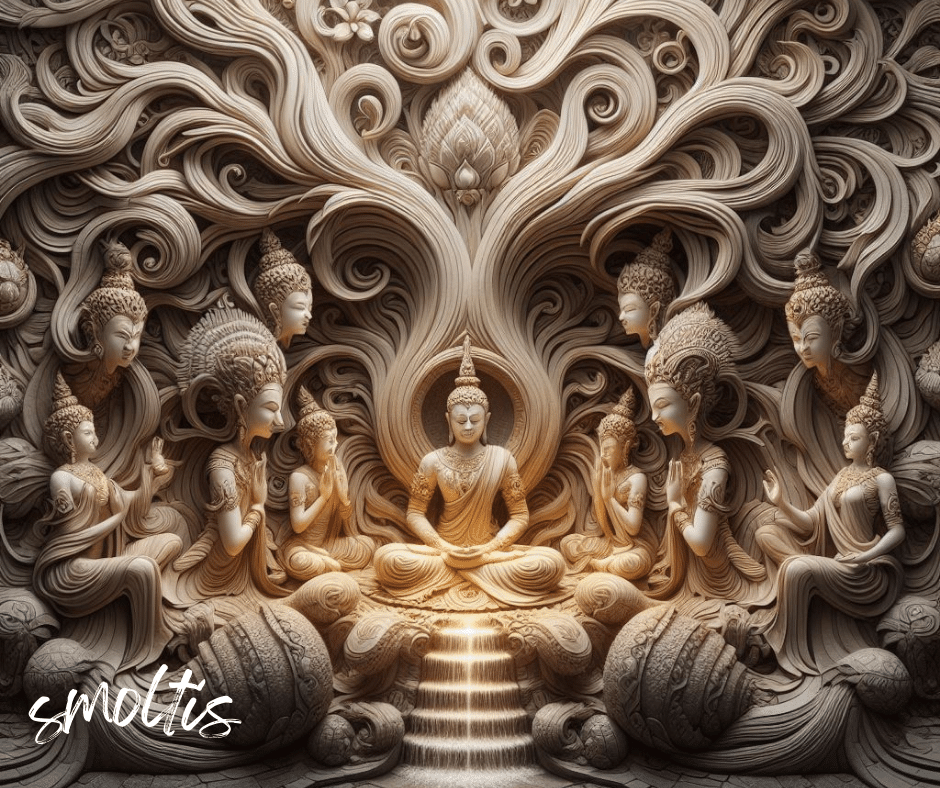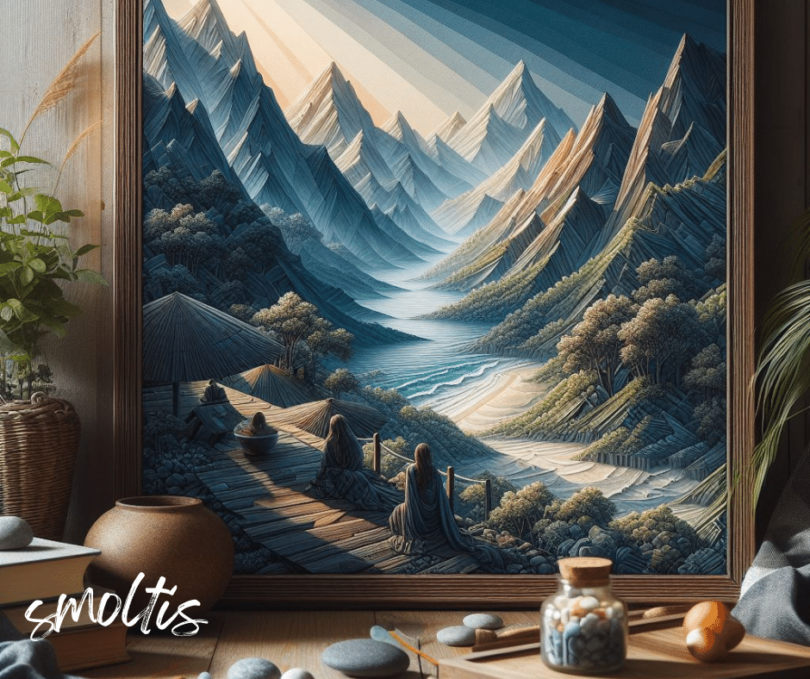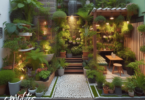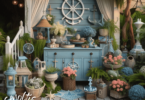Designing a shade garden can be a challenging yet rewarding endeavor. With the right planning and creativity, you can transform those dim corners of your outdoor space into a serene retreat. The key to achieving a visually appealing shade garden lies in adding depth and texture to create visual interest. By incorporating layers of lush foliage and vibrant textures, you can turn a seemingly overlooked area into a captivating oasis.

In this article, we will explore various strategies and ideas to inspire your shade garden design. From landscaping techniques to selecting the best shade-loving plants, we will provide you with the knowledge and inspiration you need to create a shady retreat in your garden.
Key Takeaways:
- By adding layers of foliage and textures, you can add depth and visual interest to your shade garden design.
- Understanding the challenges of designing a shade garden is crucial for selecting the right plants and planning the layout.
- Utilizing landscaping techniques such as natural barriers and vertical elements can maximize space and enhance the overall aesthetics of a shade garden.
- Choosing shade-tolerant plants known for their vibrant foliage and unique textures is essential for a successful shade garden.
- Texture and color can be creatively used to enhance visual interest and create focal points in a shade garden.
Understanding the Challenges of Shade Garden Design
Designing a shade garden comes with its unique set of challenges. The limited sunlight and cooler temperatures in shady areas make it essential to carefully select plants that thrive in these conditions. Choosing the right plants is key to creating a lush and vibrant shady retreat in your garden.
When it comes to shade garden design, it’s important to consider the impact of shade on the overall layout and aesthetics of your outdoor space. With the right approach, you can transform a dim area into a tranquil oasis. Whether you have a small shaded corner or an entire shaded yard, understanding these challenges will help you create a successful shade garden design.
One challenge of designing a shade garden is finding plants that can thrive and flourish in low-light conditions. Not all plants are suited for shade, and it’s crucial to choose those that have adapted to these environments. By selecting the best plants for shade gardens, you can ensure a thriving and visually appealing garden.
Another aspect to consider is the layout and arrangement of plants in a shade garden. Since full sunlight is limited, it’s important to strategically plan the positioning of plants to maximize their exposure to whatever light is available. This can create depth and visual interest in your shade garden.
Creating a shady retreat in your garden requires careful thought and consideration. By understanding the unique challenges of shade garden design, you can select the best plants for shade gardens and create a visually stunning and serene outdoor space that you can truly enjoy.
Planning Your Shade Garden: Landscaping Ideas and Inspiration
Creating a beautiful and inviting shade garden requires careful planning and creative landscaping techniques. With the right ideas and inspiration, you can transform your dim outdoor space into a tranquil oasis. Here are some practical tips to help you design the shade garden of your dreams.
1. Incorporate Shade-Loving Plants
When choosing plants for your shade garden, opt for varieties that thrive in low-light conditions. Shade-tolerant plants such as ferns, hostas, and hydrangeas are excellent choices that add lushness and texture to the landscape. Combine different plant heights, leaf shapes, and flower colors to create an eye-catching display.
2. Create Natural Visual Barriers
Use natural elements to create visual barriers in your shade garden. Incorporating trellises, fences, or tall shrubs can add depth and privacy to your outdoor space. These visual barriers not only enhance the aesthetics but also create separate zones within the garden, adding interest and functionality.
3. Maximize Space with Containers and Vertical Elements
For small or limited shade gardens, utilizing containers and vertical elements can maximize space and add visual interest. Place container plants strategically throughout the garden, using different sizes and heights to create varied levels. Vertical elements like trellises or hanging baskets can also provide additional growing opportunities for shade-loving plants.
“Incorporating different levels and visual barriers in a shade garden can create a sense of depth and dimension, making the space appear larger and more engaging.” – Landscape Designer
4. Play with Foliage Textures and Colors
In a shade garden, foliage takes center stage. Experiment with different foliage textures to add depth and variety. Combining fine, delicate leaves with bold, broad foliage can create a visually pleasing contrast. Additionally, consider using plants with colorful foliage to add pops of brightness and interest to the shaded areas.
5. Pay Attention to Groundcover Plants
Groundcover plants play an essential role in shade garden design. They not only help prevent soil erosion but also add a carpet of lush greenery. Choose shade-tolerant groundcovers like ajuga, pachysandra, or sweet woodruff to fill in empty spaces and create a cohesive look.
6. Incorporate Pathways and Seating Areas
Introduce pathways and seating areas into your shade garden design to encourage exploration and relaxation. Use stepping stones or gravel to define pathways that wind through the garden, leading visitors to hidden corners and focal points. Add benches, swing seats, or outdoor furniture to create inviting spots for enjoying the peaceful atmosphere of your shade retreat.
7. Consider Water Features
Water features such as small ponds, fountains, or bubbling rocks can bring life and serenity to your shade garden. The sound of flowing water adds a calming ambiance while attracting birds and butterflies. Place water features strategically to create focal points amidst the lush foliage.
By implementing these landscaping ideas and drawing inspiration from the beauty of shade gardens, you can create a captivating and soothing outdoor space. With careful planning and attention to detail, your shade garden will become a cherished sanctuary in your home.
Selecting the Best Plants for Shade Gardens
When designing a shade garden, choosing the right plants is crucial to create a flourishing and visually appealing space. Shade-tolerant plants are key to a successful shade garden design, as they can withstand low-light conditions and add beauty and texture to the area.
There is a wide variety of best plants for shade gardens that you can consider incorporating into your garden design. These plants are known for their vibrant foliage, colorful blooms, and unique textures. Some popular choices for shade gardens include:
- Hostas: These leafy perennials are renowned for their large, lush leaves and come in a variety of sizes and colors, adding depth and visual interest to your shade garden.
- Astilbes: With their feathery plumes of flowers in shades of pink, white, and red, astilbes add a touch of elegance and charm to any shade garden.
- Heucheras: These versatile plants are prized for their vibrant foliage colors, ranging from deep purples to bright lime greens, creating a captivating contrast in your shade garden.
- Bleeding Hearts: Known for their heart-shaped pink or white flowers, bleeding hearts bring a touch of whimsy and romance to your shade garden.
- Ferns: With their delicate fronds and graceful appearance, ferns are excellent choices for adding texture and a sense of tranquility to your shady retreat.
When selecting plants for your shade garden, it’s essential to consider factors such as soil conditions, moisture levels, and maintenance requirements. Some shade-tolerant plants thrive in moist soil, while others prefer soil that drains well. Additionally, certain plants may require regular watering or have specific pruning needs. By understanding these factors and choosing plants that align with your garden’s conditions, you can create a thriving and visually appealing shade garden.
Remember to also take into account the desired height and spread of the plants, as well as their compatibility with each other. Designing a diverse and harmonious plant arrangement will contribute to the overall beauty and cohesion of your shade garden.
By carefully selecting the best plants for shade gardens, you can create a lush and inviting space that serves as a shady retreat in your garden. Whether your focus is on vibrant foliage, colorful blooms, or a combination of both, incorporating shade-tolerant plants will bring your shade garden design to life.
Enhancing Visual Interest with Texture and Color
Texture and color play a crucial role in creating a visually captivating shade garden. By carefully selecting plants with diverse foliage textures and incorporating contrasting leaf shapes, you can add depth and intrigue to your outdoor space. Additionally, the strategic use of contrasting colors can create focal points and enhance the overall aesthetic appeal of your shady retreat.
When designing a shade garden, consider including plants with various foliage textures, such as feathery ferns, broad-leafed hostas, and spiky grasses. These different textures not only provide visual interest but also add tactile appeal, inviting visitors to touch and interact with the garden.
Incorporating contrasting leaf shapes can further elevate the visual impact of your shade garden. Pairing plants with rounded leaves, like heucheras or lungworts, with those featuring elongated, lance-shaped leaves, such as Japanese painted ferns or Solomon’s seals, creates a harmonious contrast that catches the eye.
Utilizing colors strategically is another effective way to enhance visual interest in a shade garden. Opt for plants with blossoms in vibrant hues like purples, pinks, and yellows, which stand out against the backdrop of green foliage. For example, the delicate blossoms of Bleeding Hearts (Dicentra spectabilis) add a pop of color and charm to shaded areas.
“By combining plants with different foliage textures and contrasting leaf shapes, as well as incorporating a spectrum of vibrant colors, you can create a shade garden that captivates the senses and provides a peaceful retreat,” says landscape designer Emma Thompson.
When selecting plants for your shade garden, keep in mind their light requirements and consider how they will complement each other in terms of texture and color. By carefully curating your plant selection, you can create a stunning and visually dynamic shade garden that will be the envy of your neighbors.
| Plant | Texture | Leaf Shape | Color |
|---|---|---|---|
| Heuchera | Soft, velvet-like | Rounded | Varying shades of green, purple, and burgundy |
| Ferns | Delicate and feathery | Varies (e.g., pinnate, triangular) | Green |
| Hostas | Large, broad leaves | Heart-shaped, oval | Varies (e.g., green, blue, yellow, variegated) |
| Japanese painted fern | Graceful, arching fronds | Feathery, lance-shaped | Silver and purple |
| Solomon’s seal | Graceful, arching stems | Oval, alternating | Green, variegated |
Conclusion
In conclusion, creating a visually stunning shade garden is not only possible but also essential for transforming a dim corner into a serene retreat. By incorporating the principles of shade garden design and leveraging landscaping ideas for shade gardens, you can elevate your outdoor space to new heights.
Remember to select the best plants for shade gardens, considering their shade tolerance, foliage textures, and vibrant colors. By carefully planning your shade garden layout and utilizing vertical elements, containers, and natural visual barriers, you can maximize the space and create a captivating oasis.
Don’t forget that inspiration plays a crucial role in shade garden design. Continually explore shade garden design inspiration to discover new ideas and concepts that align with your style and preferences. Whether it’s vibrant foliage, contrasting colors, or calming textures, finding inspiration will help you infuse your shade garden with creativity and uniqueness.
Now armed with the knowledge of shade garden design and landscaping ideas for shade gardens, it’s time to turn your outdoor space into a shady retreat where tranquility and natural beauty coexist. Start implementing these principles, and watch as your shade garden becomes a source of endless joy and relaxation.
FAQ
What is shade garden design?
Shade garden design refers to creating a garden specifically tailored for areas that receive limited sunlight. It involves choosing plants that thrive in shady conditions and utilizing design techniques to maximize the visual appeal of the space.
Why is creating visual interest important in shade gardens?
Creating visual interest in shade gardens is crucial to make the space inviting and pleasurable. In dim areas, layers of foliage, vibrant textures, and contrasting colors add depth and dimension, making the garden visually appealing and captivating.
What are the challenges of shade garden design?
Shade garden design comes with unique challenges. Finding plants that tolerate low-light conditions and creating an aesthetically pleasing layout in the absence of direct sunlight can be difficult. However, with careful planning and plant selection, these challenges can be overcome successfully.
How can I plan my shade garden?
Planning a shade garden involves carefully considering the layout, plant selection, and landscaping ideas. Some tips include incorporating shade-loving plants, using natural visual barriers like stone walls or trellises, and using containers and vertical elements for added interest.
What are the best plants for shade gardens?
There are several plants that thrive in shade gardens. Examples include ferns, hostas, heucheras, astilbes, and bleeding hearts. It’s essential to choose plants that suit your specific growing conditions, such as soil type, moisture levels, and available light.
How can texture and color enhance visual interest in shade gardens?
Texture and color play a significant role in creating visual interest in shade gardens. Combining plants with different foliage textures, incorporating contrasting leaf shapes, and strategically using contrasting colors can add depth and focal points to the garden, making it visually captivating.
What are some landscape design ideas for shade gardens?
Landscaping ideas for shade gardens include creating winding pathways through lush foliage, incorporating water features for added tranquility, using natural stone or mulch for texture, and incorporating seating areas or shady retreats within the garden.
How do I create a shady retreat in my garden?
To create a shady retreat in your garden, consider creating a cozy seating area under a large tree or pergola. Add comfortable seating, pillows, and soft lighting for a relaxing atmosphere. Incorporating fragrant shade-loving plants can also enhance the sensory experience.







